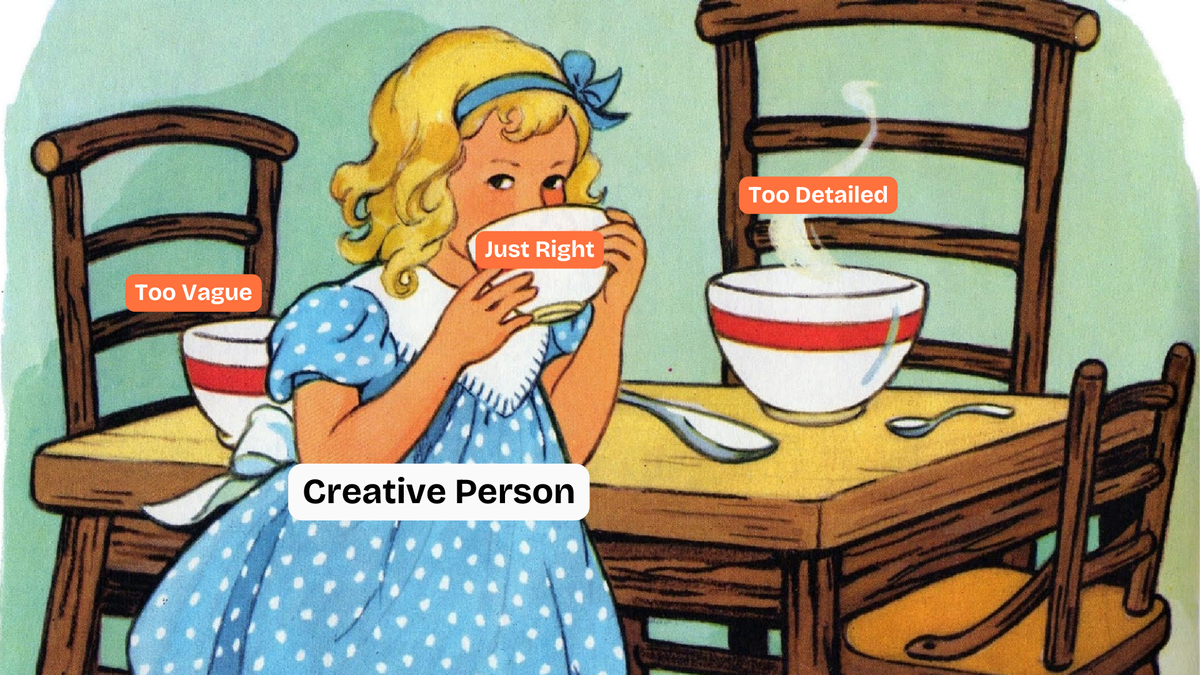Mr. Razack, my advertising and communications professor in college, told my class if you give creatives too many rules you put them in a box they can't get out of to get to the end goal. And if you don't create enough parameters you end up with something you never wanted. The key is to find that happy medium so it's just right.
As a content lead who works with everyone from writers to designers to video creators, I've found his advice to ring true.
While this seems simple enough to be mindful of, many people struggle with managing people in creative roles.
From my experience, it seems to come down to two things:
- The ability to let go of (some, not all) control and trust the people you hire
- Being able to define what you want and don't want
How good you are at these two things determines your ability to brief and review creative work. But if you are not good at these things then the following happens:
- Too Many Parameters: No room is left for creativity to breathe and contribute its full potential
- Not Enough Parameters: Creative people are left out in "the wild" with no map and a magic wand that they can supposedly wave and the perfect deliverables will be summoned into existence (eventually).
Next, I'll dig more into these two undesirable scenarios so you can figure out where on the spectrum you land in terms of having not enough to too many rules.
Afterward, I'll talk about what getting things right can look and feel like based on my trial and error.
Scenario #1: Too Many Parameters

Some (usually inexperienced) managers are afraid to delegate and trust others. For them, total control is a fail-proof solution.
If you're handing off work you used to do yourself it can be especially nerve-wracking to see someone take a different approach to the same problem. Even if you know you don't want to be a control freak, this natural fear around change is a reason you subconsciously might not realize micromanagement jail is right around the corner.
Rules are good.
But in excess, they'll not only fully clip your team's wings but also suck up time you could've invested into more meaningful work and your development as a manager.
The hard part is there's no one-number-fits-all-project-scopes when defining how many rules are enough. As project complexity varies so do parameters.
When you have too many rules your content producers know what the goal is yet they keep bumping into walls holding them back from getting there.
To figure out where you fall on the spectrum of not enough → just right → excessive parameters it helps to audit the following:
It's one thing to read the do's and don'ts. The real learning happens when a mistake is made and you take the time to explain what great looks like, plug an example if possible, and ask how they would rework things given the new information. Time consuming? Yes. But in the long term, this pays off and makes you amazing to work with.
You point fingers back at yourself with a "help me, help you" type of approach. You also are candid when giving feedback because you care about the work and the development of the people you're working with. Holding back praise or constructive critique is a disservice to everyone.
You're overly prescriptive if different people all seem to overlook a few details. You're not prescriptive enough if you keep getting back work that misses the mark (especially if it's not the first time you work with a particular person).
There are two reasons this happens. Either you're so prescriptive and convinced it's a waste of your time to give people space to learn how to get it right or you're so vague that it takes more editing rounds than expected so you do it yourself.
For example, I was hired as a social media director at a marketing agency.
The owner said they wanted a leader because they didn't know what they were doing when it came to social media marketing. But when I pitched plans and made suggestions there was nothing I was allowed to do. The micromanagement was so hardcore I could smell my boss's lunch and feel their breath on my neck while I typed up hashtags that'd be rejected in real time based on how cool they sounded.
Everything was a no-go.
A few weeks before I had my last straw, I tried to explain an idea I really believed in. I was met with immediate rejection.
The only response I got back was a single sentence.
"I have over 20 years of marketing experience," said my ex-boss before they went back into their office like a turtle popping their head back into their shell.
I was trapped in a box whose walls were made of rules that'd never help me hit our goals. The content I was making was based on nothing more than the founder's personal preferences rather than what our client's customers needed.
There was no way I would've been able to (healthily) challenge myself and grow there.
After 5-6 months I burnt out, quit, and vowed to never let my fears and ego treat anyone I'd manage or work closely with this way.
Scenario #2: Not Enough Parameters

Bad workflows are like the typical cheesy romantic comedy where the lovers could've solved things sooner if they stopped playing mind games and communicated properly from day 1. The 2-hour movie would then be a 20-minute one where the lovers talk, disagree, explain their points of view, and then come to a solution.
Like the standard Rom-Com, poor communication and a lack of understanding of what everyone involved needs leads to unnecessarily wasting time when doing creative work.
Content is not art.
Art is subjective. The value of it is in the eye of the beholder. There is no right or wrong when it comes to artistic expression.
On the other hand, the quality of content can be measured. And to assemble a quality piece of content you need to understand who it's for, its goals, how it supports the bigger picture, and what would make it great so you can make strong creative briefs.
Too many managers and creatives tend to "romanticize" content as if it's art.
Rules are dropped.
Projects flop.
It takes ages and an exaggerated amount of iterations before finally hitting the nail on the head.
Here are three signs you might be at fault for creating overly loose briefs that lead to the wrong end result:
What having the "right amount" of parameters looks and feels like

With creative briefs you need to put up a few walls to guide the creativity where you want it to go while giving it room to choose how to get there.
I've been both the person who lacks parameters and the person who has them in excess. I've found figuring out the right amount is a by-product of trial and error.
Trial and error can be messy but two things helped the process feel more productive than chaotic to me:
- Creating a solid foundation with candid communication
- Having the drive and curiosity to collect the ingredients for the brief that creatives might need to master the "recipe"
Even when I was getting some things wrong, I was always hungry for feedback from the people I collaborated with. I wanted to know what I could do better.
By welcoming feedback, I believe this also made people more receptive to receiving it.
Over time, I began to understand which aspects of my management style and my briefs needed to stay, what needed to go, and what was missing.
I became attuned to what things I needed to surface for different projects and which areas I could let breathe a bit more.
I also began to learn how to manage different people. Not everybody will respond the same way to the same treatment. The more you work with someone the more you learn how to bring out their best work.
I realized I was finally getting it right when I saw the following from the people I work with:
- Fewer Rounds of Edits: The more time I invested upfront in quality briefs and feedback then the less time I'd have to spend in the long term to help someone go from submitting something 60% of the way there to something 80% to 90% of the way there.
- Quicker Turnaround Time: Mistakes are rarely repeated because people now know what quality looks like.
- Suggestions and Questions: I began to see more people speak up about their ideas or ask questions they might be scared to ask at other workplaces (or with other clients) in fear of sounding stupid. Content is a collaborative process. Ask away and share those ideas!
In general, figuring out how to manage people will take time regardless of how much learning material you consume. Time, repetition, and reflection are your friends that will help you figure out how to best tailor your management and communication style to your work and the people you work with.
Keep your mind and communication open.
Invest time into learning about the work.
Don't be afraid to be wrong.
Don't be afraid of change.






